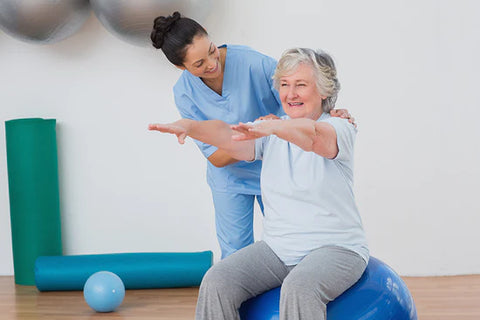Can people with asthma safely exercise? Absolutely. While asthma can make physical activity feel risky, the combination of smart planning, medical guidance, and advanced oxygen solutions can make exercise both safe and beneficial. In this guide, we explore how to manage asthma and exercise, with expert tips and tools to help you stay active without compromising your respiratory health.
Understanding Asthma and Its Impact on Exercise
Asthma and exercise often get misunderstood. Many believe that asthma prevents physical activity, but the truth is that regular movement can actually improve lung function and overall well-being—if done correctly.

Asthma is a chronic condition where inflammation narrows the airways, causing shortness of breath, coughing, or chest tightness—especially during exertion. This is known as exercise-induced bronchoconstriction (EIB). However, by using the right strategies, including oxygen solutions, individuals can safely work out, improve endurance, and boost lung strength.
What Are the Benefits of Exercising with Asthma?
Regular exercise for people with asthma can lead to:

-
Stronger respiratory muscles
-
Improved oxygen efficiency and lung function
-
Increased stamina and cardiovascular health
-
Better control of asthma symptoms
-
Lower stress and anxiety, which can reduce flare-ups
When supported by high-quality oxygen solutions, these benefits become more accessible—even for those with moderate to severe asthma.
How Can You Exercise Safely with Asthma?
People with asthma don’t have to avoid workouts. Instead, they need to approach them with intention and preparation. Here's how:
1. Talk to Your Healthcare Provider First
Before starting any fitness routine, discuss your asthma severity, triggers, and medication use with your doctor. In many cases, your physician may recommend carrying an inhaler or using portable oxygen solutions during higher-intensity activities.
2. Use Pre-Exercise Medication or Oxygen Support
Some people benefit from bronchodilators or corticosteroids taken 15–30 minutes before workouts. Others use supplemental oxygen solutions, such as a portable oxygen concentrator, to maintain stable oxygen levels and reduce the risk of symptoms mid-exercise.
💡 Pro Tip: Oxygenvip's oxygen concentrators are lightweight, travel-friendly, and designed to support active users with asthma or COPD.
3. Choose Asthma-Friendly Workouts
Low-to-moderate impact exercises that support breathing control are ideal. Examples include:

-
Swimming in a warm pool (moist air helps prevent symptoms)
-
Walking or hiking in clean-air environments
-
Indoor cycling with proper ventilation
-
Yoga, tai chi, and gentle strength training
Pairing these activities with oxygen solutions helps optimize respiratory safety and performance.
4. Warm-Up and Cool Down Properly
Jumping into a workout without prepping your body can lead to sudden bronchoconstriction. Begin with a gentle 10-minute warm-up and end with deep-breathing stretches to gradually stabilize your heart and breathing rate.
5. Monitor Air Quality and Environment
Poor air quality, cold temperatures, or high pollen counts can all trigger asthma. Check local air conditions before heading outdoors, or opt for indoor workouts with purified air and access to oxygen solutions as needed.
What Are the Best Oxygen Solutions for Active People with Asthma?
For individuals who need oxygen support during physical activity, the right tools can make all the difference. One of the most versatile options available is the VARON 1–6L Continuous Portable Oxygen Concentrator NT-06.
✅ 1–6L adjustable continuous flow oxygen supply
✅ Up to 93%±3% oxygen concentration
✅ Built-in nebulizer function at the 6L setting
✅ Replaceable battery, remote control, and versatile carrying bag
This oxygen concentrator offers an adjustable oxygen flow rate from 1 to 6 liters per minute in a continuous flow, making it a reliable companion whether you’re at home, in your car, or on the move. With three power options—AC outlet, car adapter, and a built-in 114Wh (5200mAh) battery—you’ll have the flexibility to stay active without interruption.
Its multi-functional carrying bag features wide, comfortable shoulder straps, allowing you to maintain mobility during travel, walking, shopping, or light exercise. Whether you're managing asthma and exercise indoors or outdoors, this device delivers dependable support when and where you need it most.
Explore our best-selling portable oxygen concentrators:
Browse Oxygenvip's Oxygen Solutions →
Frequently Asked Questions
Q: Can people with asthma do cardio workouts?
A: Yes, cardio is safe with asthma when approached correctly. Using inhalers, pacing your intensity, and relying on oxygen solutions can help minimize symptoms.
Q: Are there exercises asthma patients should avoid?
A: High-intensity workouts in cold or dry environments may trigger symptoms. However, with proper planning and oxygen support, most exercises can be safely enjoyed.
Q: How does oxygen therapy help during workouts?
A: Oxygen solutions help maintain optimal oxygen saturation, reduce breathlessness, and improve energy levels during physical activity.
Q: Should I exercise if I feel tightness in my chest?
A: No—pause your workout, use your inhaler if prescribed, and consult a physician. Oxygen solutions may also help stabilize your breathing during recovery.
Q: Can children with asthma exercise too?
A: Yes, with supervision and medical guidance, children can participate in sports and physical activity. Always have rescue medication and oxygen support nearby.
Final Thoughts: You Can Be Active and Breathe Easy
Asthma and exercise aren’t mutually exclusive. With the right preparation, support from healthcare providers, and reliable oxygen solutions, you can confidently build an active lifestyle that supports your respiratory health.
At Oxygenvip, we’re here to empower your movement. Our advanced oxygen concentrators are designed for people who want to breathe better, move more, and live fuller.
Shop now at Oxygenvip and take the first breath toward a healthier, more active you.


















